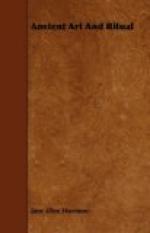“The divinity of the gods is revealed and their tranquil abodes, which neither winds do shake nor clouds drench with rains, nor snow congealed by sharp frost harms with hoary fall: an ever cloudless ether o’ercanopies them, and they laugh with light shed largely around. Nature, too, supplies all their wants, and nothing ever impairs their peace of mind.”
Greek art moves on through a long course of technical accomplishment, of ever-increasing mastery over materials and methods. But this course we need not follow. For our argument the last word is said in the figures of these Olympians translated into stone. Born of pressing human needs and desires, images projected by active and even anxious ritual, they pass into the upper air and dwell aloof, spectator-like and all but spectral.
FOOTNOTES:
[43] II, 38.
[44] Oed. Col. 694, trans. D.S. MacColl.
[45] IX, 10, 4.
[46] See my Themis, p. 438.
[47] It is now held by some and good authorities that the prehistoric paintings of cave-dwelling man had also a ritual origin; that is, that the representations of animals were intended to act magically, to increase the “supply of the animal or help the hunter to catch him.” But, as this question is still pending, I prefer, tempting though they are, not to use prehistoric paintings as material for my argument.
[48] Laws, 653.
[49] Athen. XIV, 26, p. 629.
[50] D.S. MacColl, “A Year of Post-Impressionism,” Nineteenth Century, p. 29. (1912.)
[51] D.S. MacColl, Nineteenth Century Art, p. 20. (1902.)
[52] D.S. MacColl, op. cit., p. 18.
[53] II, 18.
CHAPTER VII
RITUAL, ART AND LIFE
In the preceding chapters we have seen ritual emerge from the practical doings of life. We have noted that in ritual we have the beginning of a detachment from practical ends; we have watched the merely emotional dance develop from an undifferentiated chorus into a spectacle performed by actors and watched by spectators, a spectacle cut off, not only from real life, but also from ritual issues; a spectacle, in a word, that has become an end in itself. We have further seen that the choral dance is an undifferentiated whole which later divides out into three clearly articulate parts, the artist, the work of art, the spectator or art lover. We are now in a position to ask what is the good of all this antiquarian enquiry? Why is it, apart from the mere delight of scientific enquiry, important to have seen that art arose from ritual?
The answer is simple—




